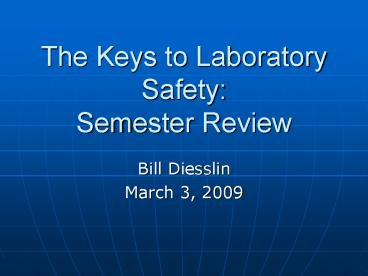The Keys to Laboratory Safety: Semester Review - PowerPoint PPT Presentation
1 / 35
Title:
The Keys to Laboratory Safety: Semester Review
Description:
Discuss OSHA Bloodborne Pathogen Training Mention that IBC approval may ... Damage to muscle, heart, organs. Moisture. Voltage. Grounding. Path through body. Area of ... – PowerPoint PPT presentation
Number of Views:42
Avg rating:3.0/5.0
Title: The Keys to Laboratory Safety: Semester Review
1
The Keys to Laboratory Safety Semester Review
- Bill Diesslin
- March 3, 2009
2
Chemical Safety in the LabRisk Management
Name two federal agencies that have regulations
that deal with chemical use in the laboratory.
3
Chemical Risk Management
What is the name of the document that is the
primary resource for information on how to use
chemicals in laboratories at ISU?
4
ISU Laboratory Safety Manual
- Introduction
- Process Planning
- Emergency Planning
- Equipment
- Training
- General Lab Safety Practices
- Safety Practices for Specific Hazards
- Management of Unwanted Lab Materials (Waste)
- Exposure Assessment and Medical Care
- Appendix I Forms
- Appendix II Lab Related Manuals
5
ISU Laboratory Safety Manual
- YOUR RESPONSIBILITIES
- Familiarize yourself with the document
- Be aware of lab hazards
- Follow Standard Operating Procedures
- Review processes with major professor
- Use equipment properly (i.e., PPE, fume hoods,
etc.) - Label, store dispose of chemicals properly
- Manage chemical inventories
- Be a good example to others
6
Personal Protective Equipment
Chemical-resistant gloves are commonly used in
the laboratory. Name 3 things to be aware of
when selecting and using chemical-resistant
gloves.
7
Personal Protective Equipment
- PPE is last line of defense
- Identify the hazards
- Selecting the right PPE
- Types available
- Minimum required in a lab
- Special cases
- Your responsibilities when wearing PPE
- Regulated by OSHA
- Part of SOPs
8
Chemical Hazard Information
Name two sources of chemical safety information.
9
Chemical Hazard Information
- Constituents of MSDS
- Health physical hazards
- Controls
- Label requirements secondary containers
- Relative to use
- Allows hazard assessment
10
Chemical Hood Usage
Name three things to keep in mind when using a
chemical hood.
11
Chemical Hood Usage
- Purpose
- Operational Characteristics
- Proper Hood Usage
- Common Usage Problems
- Servicing
12
Laboratory Inspections
Names three things that would be deficiencies
listed on a laboratory inspection form.
13
Laboratory Inspections
- POSITIVE IMPRESSIONS
- Every occupant wearing PPE
- Door has current emergency contact information
and NFPA sign - No food or drink containers in laboratory
- Room is clean and uncluttered
- Eyewash station is clean and labeled as being
tested - Chemical containers are from the 21st century
- All glassware is clean and put away when not in
use - All chemical containers has labels with names
spelled out - Centralized location for all documentation
(Laboratory Safety Manual, MSDSs, training
records, emergency contact info)
14
Hazardous Waste Disposal
The new term used to refer to waste is _________
________.
15
Hazardous Waste Handling at ISU
16
Chemical Storage
Peroxide-forming chemicals must be tested how
many months after opening of the container?
17
Chemical Storage
- Why is proper storage critical?
- Labeling
- General Storage Considerations
- Storage in Refrigerators
- Storage in Fume hoods
- Flammable Storage
18
Hazardous Materials Shipping
Name the U.S. authority for all shipments by
land, sea and air.
19
Hazardous Materials Shipping
- What materials are regulated for shipping?
- What can happen if you dont comply with the
regulations? - What are the steps involved in shipping?
20
Biosafety
What is the name for an organism that causes
diseases in humans, plants or animals?
21
Biosafety
- Recombinant DNA
- Transgenic Animals or Plants
- Bacteria, Viruses, Fungi, Prions
- Biological Toxins (e.g.Tetanus Toxin)
- Human Blood and Certain Body Fluids
- Institutional Biosafety Committee approval
22
Emergency ActionsChemical Spill Procedures
Name two things you would find in an emergency
action plan.
23
Emergency ActionsChemical Spill Procedures
- Types of emergencies
- Procedures
- Alarm systems
- Chemical spill issues
- Mercury
- Small versus large?
- Part of employee training
24
Electrical Safety
Name two types of electrical shock injuries and
two factors impacting electrical shock.
25
Electrical Safety
- Improper use of electrical equipment.
- Damaged equipment cords, plugs.
- UL-approved
- GFCI
- Vapors
26
Fire Safety in the Lab
Name the three components of the fire triangle.
27
Fire Safety in the Lab
- Fire Chemistry and Principles
- Controlling Lab Fire Hazards
- Fire Evacuation Procedures
- Fire Extinguishers
- PASS
28
Common State Fire Marshal Fire Safety Citations -
ISU
- Hallway doors opened
- Storage lt 18 below sprinkler heads
- lt 3 clearance by electric panels
- Improper use of extension cords door wedges
- Lack of orderly and clean laboratories
29
Pressure Safety
As volume increases, pressure __________ as
temperature increases, pressure __________.
30
Pressure Safety
- MAWP
- Safety Factor
- Hazards of cryogens?
- Cylinders primary/secondary hazards
31
Radiation Safety
Radiation that has enough energy to cause the
release of an orbital electron is called
__________.
32
Radiation Safety
- Radiation Types
- Ionizing
- Non-Ionizing
- Controls
- ALARA
33
Laser Safety
Name 3 ways that you can prevent exposure to a
laser beam.
34
Laser Safety
- LA-SER
- Which classes of lasers are hazardous?
- Which non-beam hazard is the most significant?
- How do you protect yourself when using a laser?
35
Thats It!































